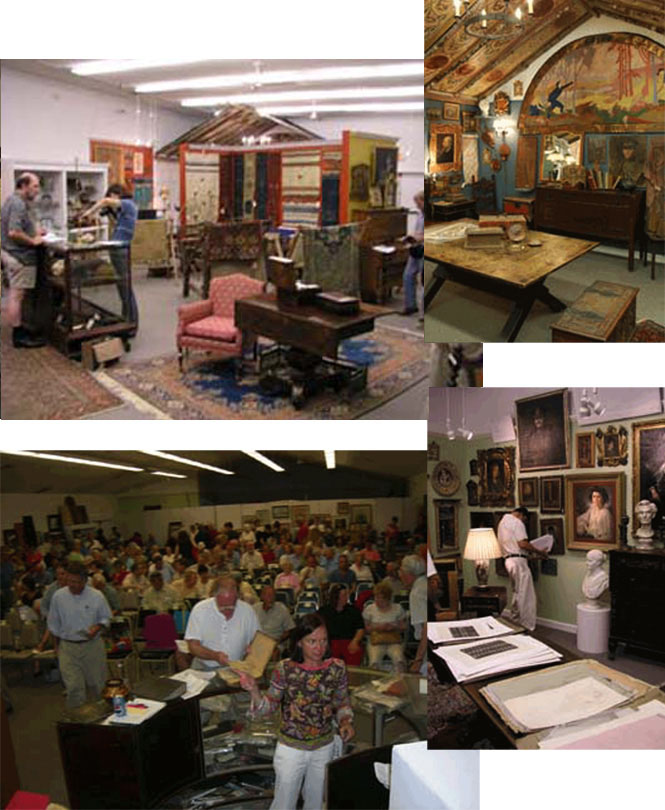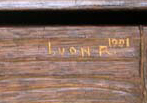 |
||
| I stopped reading antiques newspapers like Maine Antique Digest or the Newtown Bee on the theory that ignorance is bliss, but I have a guardian angel who knows my passions and keeps me posted. I didn’t know if I wanted to bless or curse him for telling me on Sunday, July 16th, about a sale in Maine that would be held the following Wednesday. After I read what I could find about the “Hewnoaks” sale at Cyr’s in Gray, I knew nothing could keep me from attending—not better judgment, not psychotherapy, not any force of nature. I thought the worst of the latter would be the heat wave, but I was wrong—the most violent of the terrible July storms hit my little Astro in New Jersey and pounded me all the way to Connecticut. Wednesday morning was bright and balmy and, by eleven, when I got to Cyr’s, the parking lot was already filling with cars and trucks. Inside the auction house was pandemonium. Even air conditioning pumping away at full force couldn’t quell the hellish heat emanating from hundreds of determined bodies pushing and tripping over each other. No telling what damage was done to the pieces on offer. I know the delicate silk curtains I bought were nowhere near as ripped when I inspected them at the preview as they were when I rescued them from being balled up in a corner on the floor the day after the sale. | ||
 |
“Hewnoaks” was the name given to the rambling, rustic Tudor cottage built on the shores of Kezar Lake in Lovell, Maine by the Douglas Volk family of artists. Douglas Volk was the son of Leonard Volk, who is famous for his many life casts of Lincoln. Douglas studied in Paris and Italy. He taught at the Cooper Union, the Art Students’ League, and the National Academy of Design in New York and was a founder of the Minneapolis School of Fine Art. He participated in the 1893 Chicago Columbian Exposition and, most compelling for me, taught at the New York Society for Ethical Culture established by Felix Adler. He married Marion Larabee in 1881 and they had two children, Marion and Wendell. Daughter Marion helped Mother Marion run the Sabatos Studio, which produced woven and printed textiles. Wendell was also a weaver as well as a woodcarver. Wendell’s wife Jessie left Hewnoaks, lock, stock, and barrel, to the University of Maine. | |
 Detail of silk side of Hewnoaks portieres. |
To the University’s great shame, they made no effort to catalogue what was a hugely important, unique time capsule documenting the American art scene at the turn of the last century. The Volks were friends with a vast network of artists, teachers, and politicians in this country and abroad including J. Alden Weir, Frank Benson, John Calvin Stevens, Childe Hassam, Steven Douglas, William Merritt Chase, John Scott Bradstreet, Felix Adler, and Karl and Anna von Rydingsvärd. The family saved every bit of correspondence, every piece of evidence of contact in scrapbooks, sketchbooks, photo albums and trunks. They also had artworks by the artists they knew: Vivian Akers, Howard Pyle, George de Forest Brush, Gardner Symons, and Frederick Monsen, among many others. Their own work at Hewnoaks represented a microcosm of the American Arts and Crafts movement. They painted murals, made and carved furniture and frames, worked copper and other metals, got local people to help them weave and print textiles, and made many of the decorations for their rustic lakeside home. I don’t object to the selling of this vital historical record—I do object to the dispersal of it in a way that its importance can never be fully realized. Even though Cyr did a Herculean job of organizing the mountains of material and the Maine State Museum and Historical Society bid heroically to keep as much as they could together, inevitably key parts went hither, thither, and yon so no one will ever know the complete story. I bought many, but not all, of the printed textiles. By accident of where I was seated at the sale, I also got the printing blocks used to make them. I hadn’t seen that box lot before the sale began and realized what it contained only because it was sitting under a table near my chair. When a runner held up one piece I could see it was a part of the pattern of the portieres I bought earlier. If I had been in the opposite corner of the hall or if the lot had come up before the actual textiles, the significance of the lot would have been lost on me. As it was I didn’t bid on some silk panels printed with C.C.C. emblems but I ended up with the blocks used to print them. I don’t need these blocks, but auction house confidentiality policies make it difficult to find out who got the panels so it is unlikely that the two parts will ever be reunited. That’s just one example of the connections that can now never be made.
The cotton side of one panel of the portieres is visible on the left side of a photograph of the interior of Hewnoaks taken in 2006. The yellow silk side was unfortunately hung facing the window, exposing it to sunlight. |
|
 Linoleum printing blocks used to print curtains. |
||
 The box of printing blocks was under the portfolio-laden table being inspected by the woman in the coral shirt. The portfolios were sold as they were found at Hewnoaks. Most had artwork by multiple artists and included charcoal drawings, monoprints, watercolors, and bits of oil-painted canvas. |
||
|
|
Scrapbooks filled with documentation of Volk’s participation in the 1893 World’s Columbian Exposition and his relationship to the once-renowned but now little-known woodcarver Karl von Rydingsvärd were separated from stacks of relevant letters. A superbly carved chest was signed on the outside “I. von Rydingsvärd.” The signature on the outside looks very recent especially when compared to the signature carved on the inside of the lid. The first letter on the inside signature is a very unusual “I” if it is in fact intended to be one. The Daughters of the American Revolution have recorded that Karl married Anna M. Davis, an author, linguist, teacher, and singer. She was ten years older than Karl so Ida may have been a second wife, although the date on the outside of the chest is 1901 and Anna published a book about the use of art in public schools in 1903. The “R” of von Rydingsvärd on the cover of Anna’s book is not a standard type font and is very like the “R” on the inside of the chest. When they were together, the Volk papers may have cleared up the confusion of names. Now clues will have to be found elsewhere. Twelve hours after arriving at the auction, I decided that it was time for me to give up, lay down my bidding number, pay my bill, and find a place to sleep off the adrenalin. The sale went on into the night and I heard that those who stuck it out until the end were rewarded with relative bargains. A fine carving by Anna/Ida that looked like a wooden version of a Gorham Martelé silver tray brought less than $1,000—had it come up at the beginning during the most heated bidding, it would have brought several times that price. I went to the auction with high hopes of finding out more about the von Rydingsvärds. I came home with some expensive bits of printed silk that have nothing to do with Karl, Anna, and/or Ida.
|
|
 First Sabatos rug shown at right as it appeared in a 1906 issue of Counntry Life in America.
|
 |
|
| I also came home with a couple of Sabatos indigo rugs. Cyr characterized Sabatos weavings as “famous,” but I had never heard of them before the auction. Once home, though, I discovered an article about them in a 1906 magazine. It seems that the Volks decided to improve upon a generations-old native tradition of making “drawn” rugs. If the rugs I have (one of which is pictured on a clothesline in the article) are examples, then a “drawn” rug is a type of hooked rather than woven rug. The Volks gathered together residents of Center Lovell, who then carried out every part of the rug making process from tending and shearing sheep to formulating the indigo dye for which they were known. The only part of the process not done by hand was the carding—the wool was taken to “the old carding mill of South Waterford, the only carding mill in a country side of many miles extent.” The article claims that the preparation for weaving a rug took one person seven days while the actual weaving was done at a rate of a half a square foot in a day. About twenty-five rugs were made in five years. The average size was 3' x 5' and they sold to “the curious summer resident” for about $50 each. The cheapest rug in the Cyr sale cost upwards of $650.
The rug pictured on the clothesline in the magazine article is apparently the first rug the Sebatos weavers ever made because it has a burlap foundation about which Wendell wrote, “The first one was drawn through burlap, but this foundation was at once given up, as not being of the same durability of the pile.” This is the kind of accidental discovery that delights me. The University delights in more profitable accidents. The auctioneers say two record-breaking (“New Rules?” Seems you can now claim an auction record by combining prices for two objects!) Pyle pirate paintings were discovered under stacks of documents in a secret room under a stairway with a locked door that was hidden behind a tall chest. To my eye, these tiny gray illustrations were neither aesthetically nor historically valuable, but Tom Veilleux and Judy Goffman thought otherwise. The University of Maine Foundation president Amos Orcutt gurgled with delight over the $103,000 realized from the two tattered canvases, which helped add over $500,000 to the foundation coffers. |
||
|
Scene of the crime: The Cyr auction company did a remarkable job producing the Hewnoaks sale. They recreated the ambience of the house interiors for the exhibition in the sale rooms and made a noble effort to keep the many parts of the many lots in some kind of order while the crowd of potential bidders sifted through hundreds of paintings and drawings, boxes of photographs, cases of scrapbooks, and plastic bags containing hundreds of letters. |
 |
|







